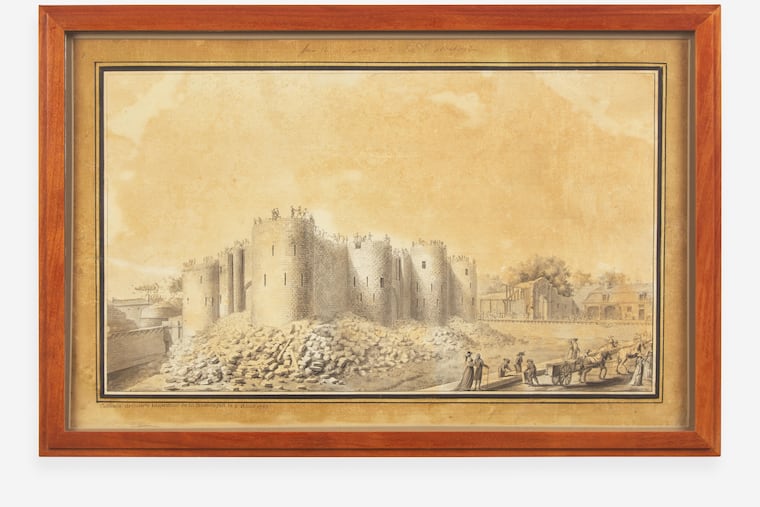A precious, rarely seen drawing from George Washington’s collection stops in Philadelphia before auction
After more than a century in private collections, 'The Destruction of the Bastille' is estimated to sell for $500,000-$800,000.

A drawing that once hung in George Washington’s presidential home on Market Street some 230 years ago will return to Philadelphia before going up for auction this fall. It was a cherished gift from the famous French general Gilbert du Motier, a.k.a. the Marquis de Lafayette, whom Washington loved like a son.
Rarely seen in public, The Destruction of the Bastille is an ink-wash drawing of the Paris prison in August 1789, weeks after revolutionaries stormed it on July 14 (now celebrated as Bastille Day), marking the beginning of the French Revolution.
The work will be on display at the Museum of the American Revolution for the month of August before heading to the auction block at Freeman’s | Hindman in September, where it’s estimated to sell for $500,000 to $800,000. Depending on the buyer, the drawing may not be on public display again.
Following the Bastille takeover, the Marquis de Lafayette ordered its demolition. One of the site inspectors in charge of breaking down the medieval fortress, Étienne-Louis-Denis Cathala drew this artwork capturing the scene on Aug. 8, 1789. Recognizing the historic significance of the moment, Lafayette sent the drawing and the iron key to the Bastille to Washington. (The key is still on display at Washington’s presidential library at Mount Vernon.)
“Give me leave, My dear General, to present you With a picture of the Bastille just as it looked a few days after I Had ordered its demolition, with the Main Kea of that fortress of despotism — it is a tribute Which I owe as A Son to My Adoptive father, as an aid de Camp to My General, as a Missionary of liberty to its patriarch,” Lafayette wrote in the letter to Washington accompanying the gifts.
“He sends an amazing letter, he basically calls Washington the patriarch of liberty. He’s very much a mentor to the young Lafayette,” said James Taub, associate curator of exhibition content and research at the Museum of the American Revolution. “There’s a father-son relationship in many regards and this object really is a material culture version of that.”
The French general first arrived in South Carolina at 19 years old, eager to fight for the Continental Army’s cause. (His zealous energy was well-documented in Apple TV+’s recent dramatized history show Franklin.) Within weeks, Lafayette was at the Battle of Brandywine outside Philadelphia, where he was shot in the calf. Washington sent his personal surgeon with explicit instructions: “Treat him as if he were my son.”
Years later, when Lafayette became the commander in chief of the Parisian National Guard, he kept in touch with his father figure. He later named his son after Washington, too. Sending the Bastille key and drawing to Washington symbolized the connections between the two countries and the resistance to their respective monarchies, as well as the deep friendship between the two revolutionary generals.
When he received the gifts, Washington said they represented “victory by Liberty over Despotism.” He hung the drawing and key in his presidential homes in New York and Philadelphia and later in Mount Vernon. Washington’s descendants kept the drawing until 1891, when they auctioned it off to a private collector. For the last 133 years, it has been in private collections, counting magazine giant William Randolph Hearst as one of its owners.
The Destruction of the Bastille is currently owned jointly by the Shriners Hospital for Children and the Masonic Charity Foundation of Connecticut, who received it as a gift from the Connecticut-based Carswell family in the late 1980s.
“It was decided that the potential proceeds of a sale could benefit the missions of both organizations,” said Darren Winston, senior vice president and cohead of books and manuscripts at Freeman’s | Hindman. “We suspect the Carswell family would be very proud that their gift will literally be able to pay dividends to all that will benefit from its sale.”
Before the Sept. 10 auction, the drawing is on tour retracing its steps. It first stopped at Didier Aaron & Cie in Paris and will be on display at the Museum of the American Revolution Aug. 1-31 before briefly going on view at Freeman’s | Hindman’s New York gallery on Sept. 4-6.
Taub says displaying the drawing ahead of the forthcoming 250th anniversary of the United States’ founding provides visitors the chance to better understand the shared history between the U.S. and France.
“It is another great opportunity to show the long-lasting impacts of not only the American Revolution, but revolutionary movements around the world,” said Taub.
The drawing will be displayed in the second-floor atrium, close to an oil portrait of Washington. Fittingly, it’s the last one he posed for as commander in chief of the Continental Army.
See “The Destruction of the Bastille” on display Aug. 1-31 at the Museum of the American Revolution, 101 S. Third St., Phila., 215-253-6731 or amrevmuseum.org.